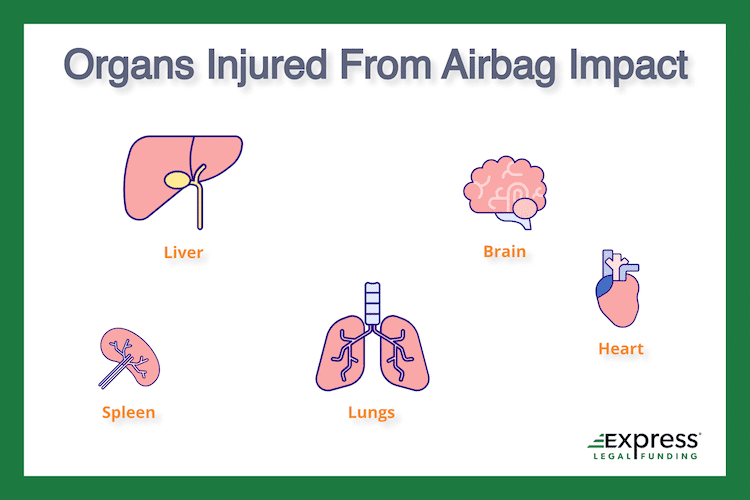
Airbags are a critical safety feature in modern vehicles, designed to protect drivers and passengers during collisions. However, while they save countless lives, airbags can also cause injuries when deployed, especially in high-impact accidents.
From minor abrasions to more severe trauma, these injuries can complicate recovery and add to the challenges of navigating the aftermath of a car accident.
In this post, we’ll dive into the common types of airbag-related injuries, how they occur, and what you can do to seek the care and compensation you deserve if you’ve been affected.

Facts: Airbag Deployment Causes Injuries
Statistics repeatedly show that airbags play a vital role in reducing the chance of severe and fatal injuries and saving lives during collisions.
An airbag’s deployment is a crucial safety feature that acts as a protective buffer by inflating and absorbing a large portion of the force upon a car crash’s impact to keep the vehicle’s occupants safer by mitigating the chance of serious injury.
However, while the life-saving potential of airbags is undeniable, safety devices are not without drawbacks.
The function of how an airbag deploys involves a controlled chemical explosion, which generates incredible speed and force, which can result in other types of injuries.
Beyond the physical implications of airbag deployment, there are also economic costs to consider.
Airbag deployment brings on additional costs, as they must be reset or replaced, which can be expensive (not applicable to cars that have been totaled), no matter how minor the accident.
This article focuses on both common and not-so-common airbag injuries and what you can do from a legal perspective if you suffer an accident that causes your car’s airbags to deploy.
However, we will start by explaining how airbags work and their history.
What Are Airbags?
Airbags are a vehicle safety feature designed to inflate rapidly (then deflate) in the event of a significant impact, cushioning the passengers and thereby reducing the risk of serious injury.

According to the National Highway Traffic Safety Administration (NHTSA), a U.S. governmental agency that regulates road safety, an airbag inflates within 15 to 50 milliseconds of a collision.
Chance of Severe Injuries Reduces When an Airbag Deploys
In addition to lowering the death rate of car accidents, some of the more common serious injuries airbags help prevent include:
- Cervical spine neck injuries
- Spinal cord back injuries
How do Airbags Work?
Airbags work by using a sensor that detects sudden deceleration, triggering an electric current that ignites a chemical propellant. This rapidly produces a large volume of gas, inflating the airbag and forming a protective cushion between the occupants and the vehicle’s interior.
What is the History of Airbags?
Airbags have an older history than you may think. The first airbag patent was filed all the way back in 1919 by a pair of Birmingham, England dentists Arthur Parrott and Harold Round.
Their time spent treating injured soldiers during WWI was the catalyst behind their invention.
The idea behind the patent was that installing airbags in cars and airplanes would reduce the chance of people suffering jaw and mouth accident injuries.
Although their patent was officially approved in 1920, historians report that the first air-filled bladders did not see use until 1951.
John W. Hetrick “Inventor of Airbag”
Who is John W. Hetrick? American John W. Hetrick (born in Newport, Pennsylvania on July 23, 1918), was an industrial engineer in the United States Navy who is credited for inventing the airbag for automotive vehicles, for which he was awarded U.S. patent #2,640,311 on August 18, 1953.
Hetrick’s design of the compressed airbag system was inspired by the compressed air torpedoes used by the U.S. Navy and his concern for protecting his family while driving on the road.
The idea came to him following a car accident he experienced with his wife and then seven-year-old daughter in which he had to swerve into a ditch to avoid hitting a deer.
Unfortunately, Hetrick did not see a financial benefit from his design since car makers were not installing airbags during the lifetime of his patent, which expired in 1971.
Nevertheless, John W. Hetrick’s invention led to the modern and legally required airbag system.
What Improvements Were Made to Airbags Over Time?
One major design issue that made Hetrick’s mechanical compressed air system less than ideal was that it used a spring or bumper contact to release, which resulted in it taking too long to fully inflate for maximum protection in a car crash.
Yasuzaburo Kobori Invented the Safety Net Airbag
Fortunately, this delay is no longer an issue due to one of the most significant breakthroughs in airbag deployment technology.

In 1964, when Japanese car engineer named Yasuzaburo Kobori (Born in what is now Kamimikawa Town, Japan, on August 25, 1899) created an explosive airbag deployment system.
His “safety net” airbag system utilizes an explosion to inflate the airbag, which was adopted worldwide and earned him patents in 14 countries.
Sadly, in 1975 Yasuzaburo Kobori and his wife took their own lives due to not finding a manufacturer willing to produce his invention (the Japanese companies at the time were concerned about the safety and legal repercussions of its using an explosive.
He passed away five years before he could see the practical application of his airbag system.
In 1980, German car company Mercedes-Benz put Kobori’s design into practical use on its S-Class of cars.

Kobori was posthumously inducted into the Japan Automotive Hall of Fame (JAHFA) in 2006.
Allen K. Breed Invented Airbag Crash Sensor to Detect Car Collisions
Who is Allen K. Breed? An inventor named Allen K. Breed (born in Chicago, Illinois, on July 27, 1927) pioneered a breakthrough in crash detection in 1967 with his ball-in-tube mechanism.
The device consisted of an electromechanical crash sensor with a steel ball attached to a tube via a magnet.
This system detected crashes more effectively and inflated airbags in 25 milliseconds.

This rapid airbag inflation was made possible by igniting sodium azide (NaN3), which converts to nitrogen, which causes the airbag to expand instead of the previously used compressed air system.
Allen K. Breed was inducted into the Automotive Hall of Fame in 1999.
GM introduced Passenger Airbags in 1973 Oldsmobile Tornado
Airbag technology experienced another critical update in 1973 when General Motors introduced front passenger-side airbag protection in the car maker’s Oldsmobile Tornado.
That was the first time a passenger vehicle that offered airbag protection for both the driver and front-seat passengers was sold in the U.S.
When Did Airbags Become Mandatory?
In the United States, airbags protecting the driver and front side passenger became legally required (mandatory) by the federal government to be installed on all cars in new cars sold in the U.S. on September 1, 1998.
Modern-Day Airbag Technology in 2023-2024
Nowadays, it has become standard for multiple types of airbags to be installed in every vehicle, with frontal airbags required by law to protect the driver and passengers.
Moreover, airbags are no longer limited to frontal airbags built into the steering wheel and dashboard.
Each year, more car models are released that have the option for extra protection, such as side airbag curtains (protect from glass) and airbags for protecting backseat passengers.
Even Some Children’s Car Seats Have Airbags Installed
Unfortunately, even with these many improvements, airbags can cause secondary injuries to a motor vehicle’s occupants once deployed, which we will now discuss.
Can Airbags Cause Injuries?
The most straightforward answer to this question is “yes.” Airbags can injure the occupants of a vehicle and possibly exacerbate any injuries caused by the collision.
Typically, these injuries result from the deployed airbag hitting the body of the driver or passengers while protecting them in a crash and do not have to involve defective airbags.
This chance of secondary injury is a tradeoff as airbag systems remain a crucial safety feature to reduce the chance of serious injury in car wrecks.
Stats: Car Crash Fatality Rate Less Due to Airbags
Statistics support this concept. Specifically, a study on vehicle safety technology published by the NHTSA reports a more than 55% drop in the fatality rate among passenger vehicle accidents where both the driver and front passenger wore three-point seat belts and there were frontal airbags installed.

With that being said, airbags most definitely can cause injuries, with some being more common and severe than others.
What Types of Injuries are Associated with Airbag Deployment?
You can suffer many different types of common airbag injuries when an airbag deploys, with surface injuries being the most common.
In addition to injuries visible on the outside of your body (i.e., lacerations, scrapes, contusions, burns, etc.), some of the most common types of airbag deployment injuries include the following:
12 Most Common Airbag Injuries:
- Facial injuries
- Broken bones in front of the skull
- Burns
- Eye injuries (including detached retinas from pressure, which can cause blindness)
- Chest injuries
- Fractured ribs
- Soft tissue injuries (contusions and sprains)
- Internal bleeding
- Nerve damage
- Traumatic brain injuries (TBI)
- Concussions (can cause tinnitus, ringing in ear symptoms)
- Pregnancy complications (blunt fetal trauma) – The NHTSA instructs women to use airbags while pregnant.
The issue is that airbag-related injuries are caused by the high speed at which an airbag deploys.
Risk of Airbag Facial Injuries
This large amount of force makes the relatively soft surface as hard as concrete.
The concept is similar to you crashing head first into a body of water from a significant height and why there is a significant risk of facial fractures and internal injuries.
Even when an airbag correctly deploys, you will likely suffer neck and back injuries (whiplash) from the force of a car accident collision.
That is because the kinetic force jostles the body and can dislocate spinal column segments, causing discomfort, pain, and possibly severe injuries to the brain.

Fortunately, with advanced airbag technology, these dangers and the chance of getting killed by an airbag are less than they used to be.
What are Advanced Airbags?
Advanced airbag deployment systems are safer because they can detect the seat position of the vehicle occupants and adjust for optimal deployment to reduce the level of injuries.
Specifically, advanced frontal airbags use the driver and passenger weights to calculate and modify deployment patterns.
Can Airbags Burn You?
Yes, airbags can cause burns upon deployment, although this lesser-known airbag injury is not associated with high heat sources in the traditional sense.
Instead, airbag burns describe abrasions resulting from friction generated by the airbag’s course fabric exterior rubbing against your skin, which is akin to rug burns.
You can also suffer chemical burns and skin irritation from your skin coming in contact with gases from sodium azide combustion, which can leak out after the airbag deploys in a car accident.
In summary, it is entirely possible for airbags to burn your exposed skin (typically, the face and arms).
Can Airbags Cause Internal Injuries or Chemical Injuries?
Yes, airbags are capable of causing internal damage due to the presence of inhalable chemicals.
Specifically, the highly toxic sodium azide used as the explosive material causes airbags to rapidly inflate and get released into the air inside the crashed car.
Fortunately for healthy people, most of the ways and amounts they can be exposed to sodium azide, including after an airbag deploys, are not likely to pose a risk of death.
Can Airbags Damage Your Lungs?
Yes, deployed airbags can damage your lungs due to inhaling sodium azide. The most dangerous type of exposure you can experience is the toxic chemical in the air (significantly more dangerous in closed spaces, i.e., in a car).
Inhaling significant amounts of sodium azide can be deadly, especially for people at risk of asthma attacks, as that can lead to a lack of oxygen in the bloodstream.
That lack of oxygen is especially likely to lead to heart and brain injuries, as the heart and brain are the organs that need the most oxygen to function.

A less severe injury is known as “airbag dermatitis,” an irritating skin condition that can result from the skin coming in contact with sodium hydroxide (a gas produced after the electrical igniter sends a charge that triggers sodium azide combust and the airbags to deploy).
Blunt Trauma From Inflating Airbag’s Impact
Unfortunately, the worst internal injuries are unrelated to the chemicals and pertain to the pressure placed on our bodies due to the seatbelt and the impact force.
With enough pressure, it is possible for a collision to cause brain injuries or damage to the liver, spleen, lungs, and heart (Blunt force aorta trauma can cause immediate death.).
Furthermore, it is typical for internal bleeding, bruising, and lacerations to occur if we hit the airbag hard enough.
Airbags can be life-saving, but in a high-speed collision, injuries are inevitable regardless of the airbag system.
Ultimately, airbag injuries are a real issue affecting anyone involved in a motor vehicle collision. These injuries necessitate a visit to the emergency room to assess the full extent of the damage.
Unfortunately, these injuries and the damage to your vehicle can be overwhelming, especially since most accidents that cause airbag deployment result in an unsalvageable vehicle.
This situation can be incredibly frustrating if the collision was not your fault but resulted from someone else’s negligence.
Fortunately, the American civil justice system allows citizens to seek compensation from negligent parties (legal action is standard when dealing with a motor vehicle accident that causes injury).
Can I File a Personal Injury Claim if My Airbags Deployed?
Yes, you can file a personal injury claim with the intent to win or settle for financial damages against another driver, regardless of whether your airbags deploy.
The only things that change from an injury perspective when your car’s airbag system deploys after a collision is:
- The odds of your surviving the car accident are significantly higher.
- The chance of your suffering severe injuries is less.
- You will likely sustain injuries from the airbag’s deployment.
Personal injury lawsuits are one of the most common civil claims filed in the United States, with motor vehicle collisions being the most common case type among them.

Ultimately, these accident lawsuits are intended to hold the negligent party accountable for their actions and financially compensate the victim for the loss that was a result of the accident.
Since airbag deployment will not influence whether the defendant was negligent, it will not directly alter whether your claim is successful in the end.
Airbag Deployment Can be Evidence in Personal Injury Lawsuits
However, when an airbag deploys in a car crash, it can cause additional injuries and indicate how hard the other car struck you.
Knowing how hard the other driver ran into you makes it easier to prove that the other driver was driving way over the speed limit.
When that is the case, your civil claim will become much stronger and improve your chances of obtaining a larger settlement or court award.
One reason for this is that reckless driving is more likely to be considered gross negligence, which can lead to your being awarded extra damages in court.
However, at the end of the day, the amount of settlement money you can receive for your injuries comes down to two main concepts, which include:
- Cost of Medical Bills: The amount of your medical bills incurred due to the motor vehicle collision directly influences the settlement you receive.
The higher the medical treatments (justified and not unrelated to your accident injuries), the higher the settlement or court award is likely to be. Generally, the average settlement is worth two times the cost of your medical. - Insurance Policy Limits: All but two states (New Hampshire and Virginia) in the U.S. require drivers to buy liability coverage from car insurance companies. Insurance comes with what is known as policy limits.
These limits, which have minimum amounts set by each state’s laws, are the maximum amount a car insurance company can be on the hook for paying to the injured party who files a claim to be compensated for their loss.
This means the policy limit can cap the amount of money you can get in a settlement regardless of how high your medical expenses add up to be.
So being badly hurt and having a lot of medical treatment does not automatically equate to the defendant will be fairly compensate for your loss.
With all this being said, you must take the proper steps after a car accident when airbags have deployed to maximize your recovery from both a health and monetary settlement perspective.
What to do After Airbags Deploy?
After a car accident collision that caused your car’s airbags to deploy, your first priority needs to be seeking medical attention, which begins with notifying the authorities of the accident (dial 911 in the United States).
By doing so, you can tell the police you need medical attention (always important, even following a mild car accident), as they will send an ambulance out to the scene to evaluate you.
Get Medical Care After Car Accident With Airbag Deployment
After receiving the initial evaluation from the emergency response technician (EMT), you should go to the emergency room to be further checked out by a doctor, even if you feel fine and not in pain.
The are several reasons to go to the ER, regardless of how your body feels, which include:
- You Might Not Realize Extent of Injuries: Airbag deployment in motor vehicle collisions can cause internal injuries, which can be lethal (i.e., internal bleeding).
Due to these injuries being internal and cannot be seen with the naked eye, you may not realize that you incurred these injuries until much later due to adrenaline being pumped into your bloodstream.
Adrenaline is a hormone that gets released by the adrenal glands (on top of the kidneys) that deadens pain in fight-or-flight situations like car accidents to allow us to push through the pain to safety.
Also, you can suffer a concussion from getting hit in the head by a deployed airbag, which by default hurts your ability to make sound decisions, like not delaying an evaluation by a doctor.
- Protects Value of Your Case: Getting seen by a doctor immediately following an accident is crucial to securing the maximum compensation for your claim, especially if you suffered significant injuries.
Insurance adjusters and their defense attorneys typically claim that plaintiffs that were not evaluated by a doctor soon after an accident are not as injured as they and their personal injury attorney claim.
When this happens, the value of your medical can be reduced, even if your medical care was justified. - Get Referred to Specialists: After an Emergency room doctor runs tests, like bloodwork and x-rays, they can refer specialists who can treat your particular injuries and create a recovery plan.
Each visit to a medical professional adds to the overall cost of treatment and includes expenses that would never have affected you had the other driver been more aware.
Additionally, seeing and receiving medical care from specialists, such as epidural steroid injections, legitimizes the severity of your car collision and airbag deployment injuries.
These costs are used to calculate how much an insurance company will offer you as a settlement (Of course, there is a good chance your personal injury lawyer will need to mediate the case and advise you not to take the initial settlement offer.).
The complete medical expenses you incur determine a baseline for the settlement you receive since it is designed to help you avoid paying your medical costs out-of-pocket.
In addition to proper medical treatment, there is something else people in car accidents need to consider.
Should You Hire an Airbag Injury Lawyer?
Yes, you should hire an airbag injury lawyer to represent you on your claim to maximize your settlement. Navigating a personal injury claim is not simple, and an experienced attorney can guide you on how to do it most effectively.
It’s also the responsibility of your attorney and law firm to negotiate directly with the at-fault party (most often, the negligent driver’s insurance company) which you want.
Deployed Airbag Car Accident Injury Settlements
Even though you will owe your attorney a percentage-based fee (contingency fee-based agreement), typically between 33%-40%, in all likelihood, you will get more money than if you tried to settle the case yourself.
These legal professionals are “no win, no fee” car accident lawyers since they only take their fee if you settle or win your case for money.
The best place to start in finding an attorney to represent you on your airbag deployment lawsuit is to search “free consultation with a lawyer” or the similar online.
Scheduling a free consult and case evaluation is how you will begin to get the ball rolling from a legal claim perspective.
Closing Statements on Airbag Injuries
Unfortunately, the nature of why these lawsuits need to be filed in the first place means you will be dealing with extra costs while your car accident attorney fights on your behalf (i.e., airbag service light repairs).
Read on to learn why financial hope does not need to be lost, even if you find yourself amid this challenging situation, and most importantly, how we can help.

We at Express Legal Funding understand the concept of being low on cash after a car accident. We are a company with nearly a decade of experience helping people from all walks of life in this situation.
We know how difficult it can be to keep up with all your monthly bills, even when you have a well-paying job.
However, where we are experts is crucial to the effective services that we can provide.
That is, we understand how it can feel nearly impossible to keep up with your bills when are having to deal with sudden medical care and car repair (or replacement) costs during a pending car accident lawsuit.
Fortunately, we, as a legal funding company, have good news. Helping people financially in these personal injury lawsuit situations is what we do.
Pre-settlement Cash Advances for Car Accident Lawsuits
Specifically, we can help injured victims by advancing them funds for their case while they are hurt, out of work, and waiting for a settlement.
The unique and helpful financial option we offer is known as pre-settlement funding. Consumer legal funding process becomes straightforward once you learn about how the process works, which is as follows:
- You must have another party you seek compensation from in a lawsuit.
- Pre-settlement funding companies can advance your funds by purchasing a portion of your potential settlement or court award (It’s not a loan). Instead, the lien is placed on your claim. The deal is made by signing a legal funding agreement and receiving the funds.
- In addition to you and the funding company signing, your attorney will sign an acknowledgment that says they represent you, expect you will be able to recover money from your claim, and that once the claim resolves, they will disburse the money the pre-settlement funding is owed before sending your final settlement check to you in the mail.
- That means the legal funding company will only be paid when you successfully recover compensation for your loss.
If you go to court and lose, the non-recourse funds advanced to you are yours to keep, which could not technically be the case if the financial product were a pre-settlement loan (a small handful of states require the advance to be made as a recourse loan).
A big plus of pre-settlement funding is risk-free and a personal debt-free financial option.
So if you or someone you know got hurt in a car accident where the airbags deployed (or another serious injury situation) and need access to money now, not only after your case ends, you should give us a call or apply online anytime, 24/7 to get a pre-settlement cash advance for your case.
That’s the financial service we provide, and we are here to help!
At Express Legal Funding, we take the stance that knowledge is power, so we encourage you to read more of our industry-leading blog articles, including dozens of expertly written legal topics.


